|
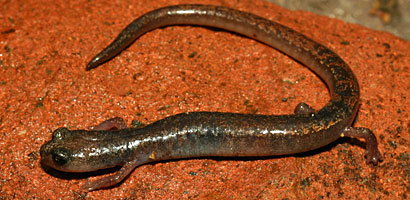 |
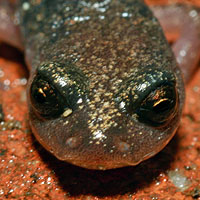 |
| Adult, Santa Cruz Island, Santa Barbara County |
 |
 |
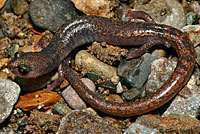 |
| Adult, Santa Cruz Island, Santa Barbara County |
 |
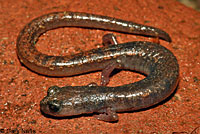 |
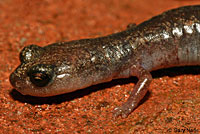 |
| Adult, Santa Cruz Island, Santa Barbara County |
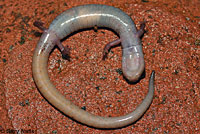 |
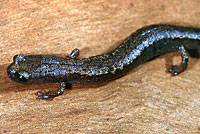 |
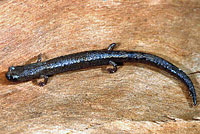 |
| Underside of adult, Santa Cruz Island, Santa Barbara County |
Adult, Santa Cruz Island, Santa Barbara County |
 |
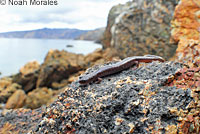 |
| Adult, Santa Cruz Island, Santa Barbara County © Noah Morales |
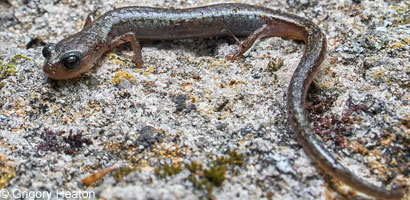 |
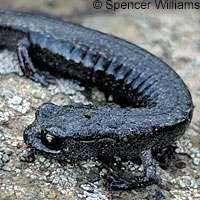 |
Adult, Santa Rosa Island, Santa Barbara County
© Grigory Heaton |
Adult, Santa Cruz Island,
Santa Barbara County
© Spencer Williams |
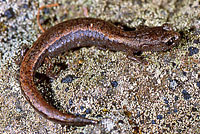 |
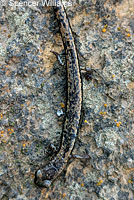 |
|
Adult, Santa Cruz Island,
Santa Barbara County |
Adult, Santa Cruz Island,
Santa Barbara County
© Spencer Williams |
|
| |
|
|
| Comparison with Sympatric Slender Salamander |
 |
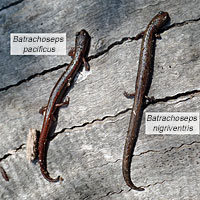 |
|
Left: Juvenile B. nigriventris - Black-bellied Slender Salamander
Right: Juvenile B. pacificus
Santa Cruz Island, Santa Barbara County
B. pacificus has proportionally larger body, legs, and toes, and a lighter venter. |
Left: Juvenile B. pacificus
Right: Juvenile B. nigriventris - Black-bellied Slender Salamander
Santa Cruz Island, Santa Barbara County
B. pacificus has proportionally larger body, legs, and toes, and a lighter venter.
|
|
| |
|
| Habitat |
|
 |
|
Santa Cruz Island,
Santa Barbara County |
Santa Cruz Island,
Santa Barbara County |
Habitat, beach driftwood on
Santa Cruz Island |
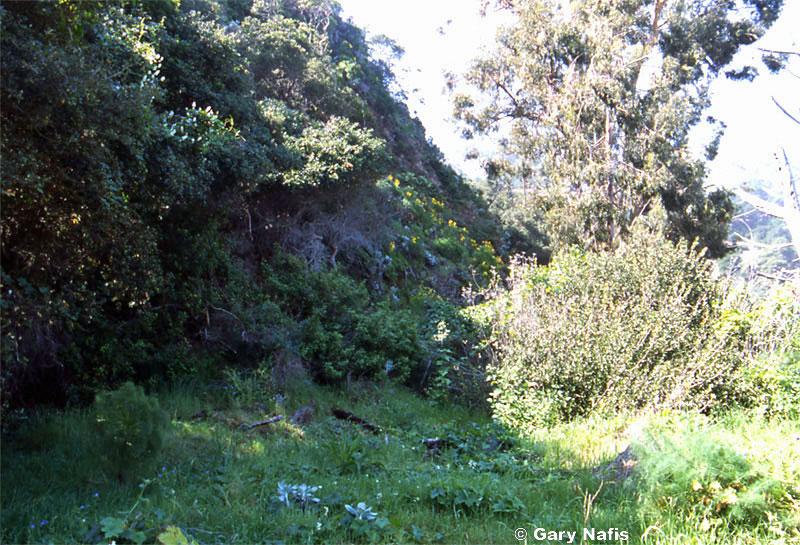 |
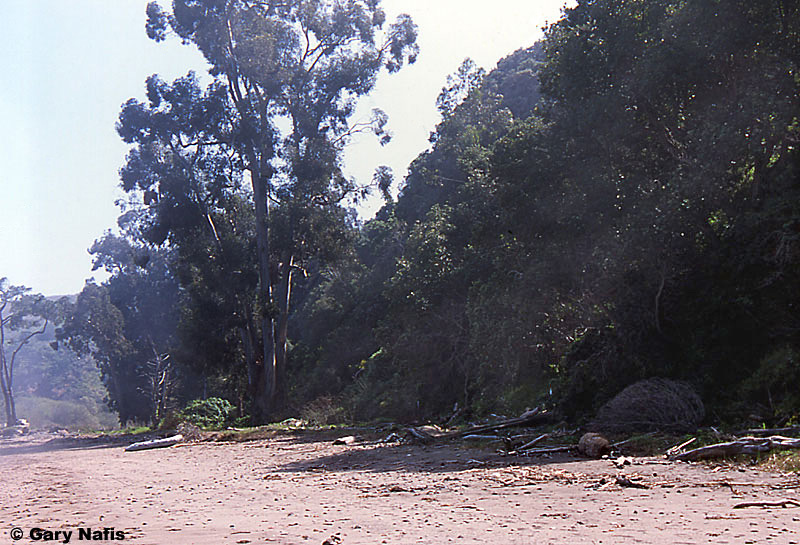 |
 |
| Habitat, near sea level, Santa Cruz Island, Santa Barbara County |
Habitat, next to beach,Santa Cruz Island, Santa Barbara County |
Santa Cruz Island,
Santa Barbara County
© Spencer Williams |
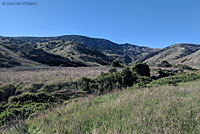 |
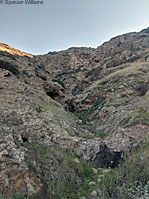 |
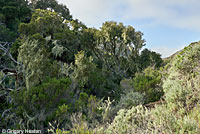 |
Santa Cruz Island,
Santa Barbara County
© Spencer Williams |
Santa Cruz Island,
Santa Barbara County
© Spencer Williams |
Santa Rosa Island,
Santa Barbara County © Grigory Heaton |
|
|
|
| Description |
| |
| Size |
Adults are 1 2/3 - 2 3/4 inches long (4.2 - 7 cm) from snout to vent.
|
| Appearance |
A small slim salamander with 18 - 20 costal grooves.
Fairly robust for a Slender Salamander, with relatively long legs.
Short limbs, a narrow head, long slender body, very long tail, and conspicuous costal and caudal grooves give this species the worm-like appearance typical of most Slender Salamanders.
There are four toes on the front and hind feet, which is also typical of Slender Salamanders.
(Other California salamanders have five toes on the hind feet.)
|
| Color and Pattern |
Color is brown to pinkish above with a wide dorsal stripe with indefinite borders, and may be made up of many light speckles. The throat and underside of the tail are pale and the venter is whitish or slate, with light and dark speckling.
|
| Comparison with Sympatric Slender Salamanders |
Coexists with B. nigriventris on Santa Cruz Island.
Differentiated by ventral color - dark on B. nigriventris, and light on B. pacificus, and by the darker color, smaller, slimmer body, and thinner limbs of B. nigriventris.
|
| Life History and Behavior |
A member of family Plethodontidae, the Plethodontid or Lungless Salamanders.
Plethodontid salamanders do not breathe through lungs. They conduct respiration through their skin and the tissues lining their mouth. This requires them to live in damp environments on land and to move about on the ground only during times of high humidity. (Plethodontid salamanders native to California do not inhabit streams or bodies of water but they are capable of surviving for a short time if they fall into water.)
Plethodontid salamanders are also distinguished by their nasolabial grooves, which are vertical slits between the nostrils and upper lip that are lined with glands associated with chemoreception.
All Plethodontid Salamanders native to California lay eggs in moist places on land.
The young develop in the egg and hatch directly into a tiny terrestrial salamander with the same body form as an adult.
(They do not hatch in the water and begin their lives as tiny swimming larvae breathing through gills like some other types of salamanders.) |
| Activity |
Little is known about this species.
Most Slender Salamander species are active on rainy or wet nights when temperatures are moderate, fall through spring, retreating underground when the soil dries or when air temperature drops to near freezing.
The cool marine climate of the Channel Islands, including summer fog, provides enough moisture for this species to be active all year.
Found under rocks, logs, bark, and other debris.
|
| Defense |
Slender salamanders use several defense tactics, including:
- Coiling and remaining still, relying on cryptic coloring to avoid detection.
- Uncoiling quickly and springing away repeatedly bouncing over the ground, then remaining still again to avoid detection.
- Detaching the tail, which wriggles on the ground to distract a predator from the salamander long enough for it to escape.
(After its tail is detached or severed, the salamander will grow a new tail.) |
| Diet and Feeding |
Most likely eats a variety of small invertebrates.
Feeding behavior is not well known, but other Batrachoseps species are sit-and-wait predators that use a projectile tongue to catch prey. |
| Reproduction |
Little is known about the breeding behavior of this species.
|
| Eggs |
| Other species of Slender Salamanders lay eggs in moist places on land. |
| Young |
Young develop completely in the egg and hatch fully formed.
|
| Habitat |
Inhabits coastal scrub, grassland, oak woodland, and beach driftwood.
|
| Geographical Range |
Endemic to California.
Found only on Santa Cruz, San Miguel, Santa Rosa, and Anacapa Islands. |
| Elevational Range |
From sea level to around 1,410 ft. elevation (430 m).
|
| Notes on Taxonomy |
Several Slender Salamander species found on the south coast, in the Sierra Nevada Mountains, and in southern California were formerly known as Batrachoseps pacificus. In 2000, Wake and Jockusch placed all but the Channel Islands species in other taxa.
Here's a Diagram of the Batrachoseps Complex showing the relationships between species.
Alternate and Previous Names (Synonyms)
Batrachoseps pacificus - Channel Islands Slender Salamander (Stebbins 2003)
Batrachoseps pacificus pacificus - Channel Islands Slender Salamander (Stebbins 1966, 1985)
Batrachoseps attenuatus pacificus - Pacific Worm-salamander (Bishop 1943)
Batrachoseps pacificus - Channel Islands Salamander (Storer 1925)
Batrachoseps pacificus - Island Salamander - Pacific Lizard (Grinnell and Camp 1917)
Batrachoseps pacificus (Yarrow 1883)
Hemidactylium pacificum (Cope 1885)
|
| Conservation Issues (Conservation Status) |
| No threats are known to this species, but it might be vulverable due to its limited isolated island habitat. |
|
| Taxonomy |
| Family |
Plethodontidae |
Lungless Salamanders |
Gray, 1850 |
| Genus |
Batrachoseps |
Slender Salamanders |
Bonaparte, 1841 |
Species
|
pacificus |
Channel Islands Slender Salamander |
(Cope, 1865) |
|
Original Description |
Cope, 1865 - Proc. Acad. Nat. Sci. Philadelphia, Vol. 17, p. 195
from Original Description Citations for the Reptiles and Amphibians of North America © Ellin Beltz
|
|
Meaning of the Scientific Name |
Batrachoseps - Greek - batrachos = amphibian, frog + seps = lizard — describes lizard-like appearance
pacificus - NL - of the Pacific Ocean — found on the Northern Channel Islands, off the California coast
from Scientific and Common Names of the Reptiles and Amphibians of North America - Explained © Ellin Beltz
|
|
Similar Neighboring Salamanders |
B. nigriventris
B. m. major
|
|
More Information and References |
California Department of Fish and Wildlife
AmphibiaWeb
Hansen, Robert W. and Shedd, Jackson D. California Amphibians and Reptiles. (Princeton Field Guides.) Princeton University Press, 2025.
Stebbins, Robert C., and McGinnis, Samuel M. Field Guide to Amphibians and Reptiles of California: Revised Edition (California Natural History Guides) University of California Press, 2012.
Stebbins, Robert C. California Amphibians and Reptiles. The University of California Press, 1972.
Flaxington, William C. Amphibians and Reptiles of California: Field Observations, Distribution, and Natural History. Fieldnotes Press, Anaheim, California, 2021.
Nicholson, K. E. (ed.). 2025. Scientific and Standard English Names of Amphibians and Reptiles of North America North of Mexico, with Comments Regarding Confidence in Our Understanding. Ninth Edition. Society for the Study of Amphibians and Reptiles. [SSAR] 87pp.
Samuel M. McGinnis and Robert C. Stebbins. Peterson Field Guide to Western Reptiles & Amphibians. 4th Edition. Houghton Mifflin Harcourt Publishing Company, 2018.
Stebbins, Robert C. A Field Guide to Western Reptiles and Amphibians. 3rd Edition. Houghton Mifflin Company, 2003.
Behler, John L., and F. Wayne King. The Audubon Society Field Guide to North American Reptiles and Amphibians. Alfred A. Knopf, 1992.
Robert Powell, Roger Conant, and Joseph T. Collins. Peterson Field Guide to Reptiles and Amphibians of Eastern and Central North America. Fourth Edition. Houghton Mifflin Harcourt, 2016.
Powell, Robert., Joseph T. Collins, and Errol D. Hooper Jr. A Key to Amphibians and Reptiles of the Continental United States and Canada. The University Press of Kansas, 1998.
American Museum of Natural History - Amphibian Species of the World 6.2
Bartlett, R. D. & Patricia P. Bartlett. Guide and Reference to the Amphibians of Western North America (North of Mexico) and Hawaii. University Press of Florida, 2009.
Bishop, Sherman C. Handbook of Salamanders. Cornell University Press, 1943.
Lannoo, Michael (Editor). Amphibian Declines: The Conservation Status of United States Species. University of California Press, June 2005.
Petranka, James W. Salamanders of the United States and Canada. Smithsonian Institution, 1998.
Joseph Grinnell and Charles Lewis Camp. A Distributional List of the Amphibians and Reptiles of California. University of California Publications in Zoology Vol. 17, No. 10, pp. 127-208. July 11, 1917.
|
|
|
The following conservation status listings for this animal are taken from the April 2024 State of California Special Animals List and the April 2024 Federally Listed Endangered and Threatened Animals of California list (unless indicated otherwise below.) Both lists are produced by multiple agencies every year, and sometimes more than once per year, so the conservation status listing information found below might not be from the most recent lists. To make sure you are seeing the most recent listings, go to this California Department of Fish and Wildlife web page where you can search for and download both lists:
https://www.wildlife.ca.gov/Data/CNDDB/Plants-and-Animals.
A detailed explanation of the meaning of the status listing symbols can be found at the beginning of the two lists. For quick reference, I have included them on my Special Status Information page.
If no status is listed here, the animal is not included on either list. This most likely indicates that there are no serious conservation concerns for the animal. To find out more about an animal's status you can also go to the NatureServe and IUCN websites to check their rankings.
Check the current California Department of Fish and Wildlife sport fishing regulations to find out if this animal can be legally pursued and handled or collected with possession of a current fishing license. You can also look at the summary of the sport fishing regulations as they apply only to reptiles and amphibians that has been made for this website.
|
| Organization |
Status Listing |
Notes |
| NatureServe Global Ranking |
G3G4 |
Vulnerable-Apparently Secure |
| NatureServe State Ranking |
S3S4 |
Vulnerable-Apparently Secure |
| U.S. Endangered Species Act (ESA) |
None |
|
| California Endangered Species Act (CESA) |
None |
|
| California Department of Fish and Wildlife |
None |
|
| Bureau of Land Management |
None |
|
| USDA Forest Service |
None |
|
| IUCN |
LC |
Least Concern |
|
|
|






























